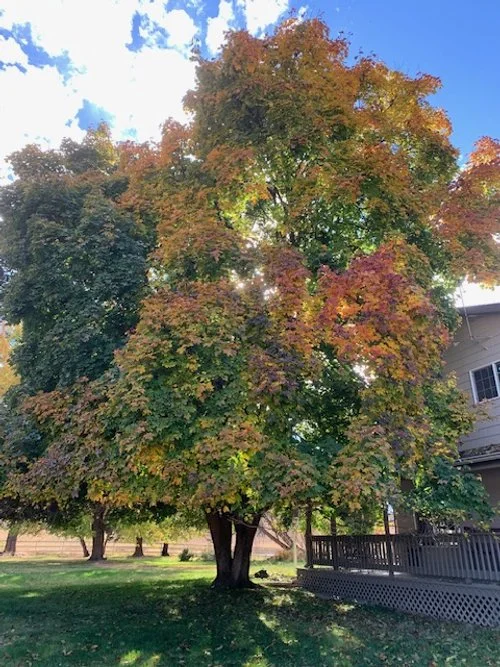Maple Syrup 2025
February 19, 2025. It’s still snowing outside on this wet and dreary day. But a pair of bright orange snowshoes strapped to feet, a drill primed and ready, and a couple of food-grade buckets with holes in the lids are about to change the atmosphere. Temperatures around 40 degrees Fahrenheit during the day and just below freezing overnight are the recipe for one sweet treat: Maple Syrup.
The two maple trees in our front yard get glory for the few short moments before winter turns into spring. The one tricorn tree closest to the house (a beautiful display of orange, green, and red in the fall. See the last picture) and the lone trunk tree are some of our farm's newest “tapped into” resources.
Maple sap collection predates the first settlers coming to North America. The Indigenous people collected the syrup and boiled it down with hot stones in what was called “sugar bushes”. Ever since then, people have enjoyed sweet syrup in and on a variety of foods: pancakes, coffee, and even desserts!
Our maple sap collection isn’t a booming business, but three years into the process has taught us a lot. First, an inch and a half holes are bored into the trees near the base of the truck, preferably over a large root. Then a “spile” is gently tapped into the hole. In our case, an opaque hose is attached to the spile and curves down into a food-grade bucket through holes drilled in the lid. A few times a day (depending on the sap production) the sap is collected until there is enough to begin the boil process.
Two giant cheese pots over an outside double-burner propane camping stove are carefully monitored until the sugar-to-water ratio is close to the desired level (around 66-68% brixs on the refractometer) and strained and brought inside where it can be more diligently watched and stirred. When the syrup has the desired sugar content, color, and flavor, it is strained once more before being ladled into small jars or bottles. Once the process is finished, the bottles are stored in a cool location.
All in all, about 40 gallons of sap make about a gallon of syrup. This makes the syrup another form of “liquid gold”! This slow-going process is finished when the temperature no longer gets below freezing at night and about forty degrees Fahrenheit during the day. During this temperature change, the tree begins to leaf, which turns the sap bitter. After cleaning the tools and storing for the summer, the trees get a break until the turn of next winter to spring.
Contributed by: E.S







